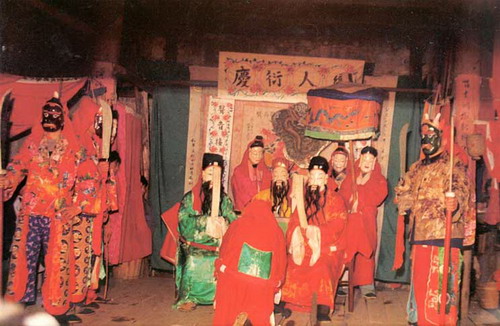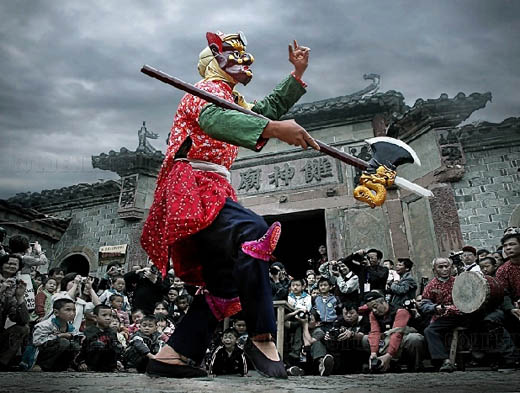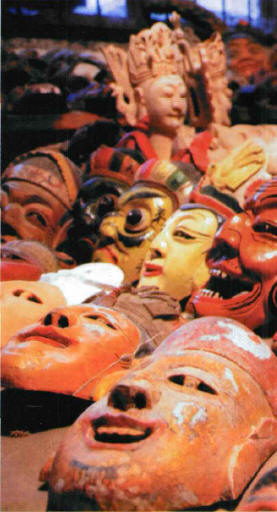Lofty Lushan Mountain
Temples in Hidden Places
On the First of August
Wheels by the Water
Share your travel story with regional@chinadaily.com.cn
Nuo culture
( chinaculture.org, en.jxwmw.cn, english.jiangxi.gov.cn, chinadaily.com.cn )
Updated: 2011-08-19
 |
| The Nuo opera |
Nuo, also called the "Nuo sacrifice" or "Nuo ceremony," was originally a type of sacrificial and magical ritual held to expel evil spirits and pestilence. Its name is derived from one of such rituals, where people shouted "nuo, nuo" to drive away the devil.
Nuo culture is composed of Nuo Temple, Nuo dance, Nuo mask, Nuo opera, Nuo symbol and Nuo weapon, etc, related to anthropology, folklore, religion and drama.
Jiangxi province is a cradle of Nuo operas, which are also staged in some southern and southwestern provinces and autonomous regions. Jiangxi's Nuo, also called Gan Nuo, began from the early Han Dynasty. Gan Nuo integrally preserves the original Nuo rituals in ancient times.
Nuo temple, Nuo mask, Nuo ritual and Nuo opera form the Nuo culture groups with distinct Jiangxi local characteristics. After thousands of years, Nuo performances are still very popular as a folk custom. According to the statistical data in 1995, 25 counties (cities) had Nuo performances; and 247 Nuo dances and Nuoxi shows were still remaining in the whole province.
Jiangxi Nuo is honored the “living fossil” of ancient culture by academe and was invited several times to France, Japan, Korea, Singapore and other countries and regions for performance and communication.
Nuo dance
 |
| Jiangxi Nuo dance |
The Nuo dance was originally performed during the 12th lunar month to drive away evil spirits and pray for a harvest during ancient times. The Nuo ceremony was first recorded on bones and tortoise shells during the Shang Dynasty (16th - 17th century BC), and flourished in the Zhou Dynasty (11th century – 256 BC). As the number of its participants increased from 100 to 1,000, the ceremony became more and more magnificent. At the time, besides the grand Nuo ceremony held by the royal court, the folk Nuo ceremony also appeared in the countryside.
Evolving over centuries, the content and technique of Nuo dance grow richer. Yet with the development of science and technology, Nuo dance has gradually become more of a recreation than a ritual. In recent decades, the ceremony is more a theatrical performance for entertainment and expresses farmers' longing for good weather, bumper harvest and family prosperity.
Nowadays, the Nuo dance drama still prevails in a number of Chinese provinces, including Jiangxi, Hunan, Hubei, Guizhou, Anhui, Shandong and Hebei.
Nuo mask

The main characters in the dance dramas all wear vivid, lifelike, wooden masks, featuring the distinctive folk styles of the Yellow River Valley.
The masks play a very important role. During the Shang and Zhou dynasties, when the sacrifice was prevalent, the emcee of the ritual wore a golden mask with four eyes to frighten away ghosts and devils.
In Nuo drama performances, masks are the most important prop and a major characteristic that distinguishes this drama from the others.
Each Nuo mask has a fixed name, represents a certain role and has legendary stories to tell about its origins.
The masks can appear valiant and martial, stern and tough, or gentle and kind, and they come in various styles to represent different figures. For instance, since the responsibility of valiant gods is to emit awe and dispel ghosts and devils, their masks usually have horns and buckteeth, with a very ferocious countenance.
Nuo masks are the result of primitive religion and totem worship. From sun, to earth, to deity worship, Nuo performances reveal the secrets of the evolution of ancient societies. After thousands of years of evolution, some heroic figures in history were deified and became the incarnation of kindness, bravery and justice. Thus, Nuo masks became richer and more loved by ordinary people.




